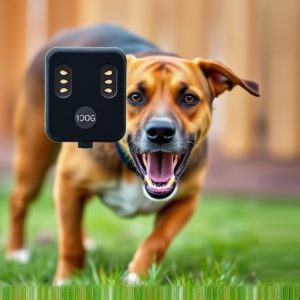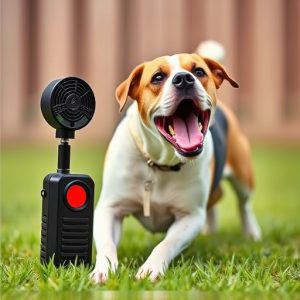Protect Your Devices: Dog Repellents & EMC Safety Requirements
Dog repellents protect electronic devices from canine damage using scent, sound, and visual cues. Ke…….
Dog repellents protect electronic devices from canine damage using scent, sound, and visual cues. Key considerations are EMC certification to prevent EMI interference and weather-resistant design for outdoor use. Effective, safe repellents, often featuring natural ingredients or ultrasonic technology, safeguard electronics and dogs' well-being. Future trends include EMF control to meet Dog Repellent EMC Certification Requirements and smart, adaptive systems prioritizing animal welfare and human safety.
In the digital age, protecting our electronic devices from unexpected intruders, such as dogs, is essential. Dog attacks on sensitive tech can cause significant damage, leading to costly repairs or permanent device failure. This article explores effective strategies to safeguard your gadgets from furry foes. From understanding dog repellents and their mechanisms to delving into EMC Certification—a vital standard ensuring device immunity from electromagnetic interference—we provide a comprehensive guide. Learn how to choose the ideal dog repellent, implement best practices, and stay ahead of emerging trends in dog-repellent technology, including innovative solutions that promote both pet safety and device integrity.
- Understanding Dog Repellents: How They Work
- EMC Certification: Ensuring Device Safety from Electromagnetic Interference
- Choosing the Right Dog Repellent for Your Electronic Devices
- Implementing Dog-Friendly Electronic Devices: Best Practices
- The Future of Dog-Repellent Technology: Innovations and Trends
Understanding Dog Repellents: How They Work
Dog repellents are designed to deter canine aggression and protect electronic devices from potential harm. These repellents often rely on a combination of scent, sound, and visual cues to trigger an aversion response in dogs. The primary mechanism at play is sensory overload, where the device emits strong, unpleasant odors or high-frequency sounds that are off-putting to dogs but harmless to humans.
When selecting a dog repellent for electronic devices, it’s crucial to consider factors like EMC (ElectroMagnetic Compatibility) certification requirements. This ensures that the repellent does not interfere with the device’s electromagnetic signals. Repellents should be specifically designed for outdoor use and equipped to withstand various weather conditions without compromising their effectiveness. Understanding these aspects can significantly contribute to preventing dog attacks on valuable electronic gear, ensuring both device longevity and canine safety.
EMC Certification: Ensuring Device Safety from Electromagnetic Interference
Dogs, despite being man’s best friend, can sometimes pose a threat to electronic devices with their playful nips and enthusiastic bites. To protect your gadgets from such incidents, especially in outdoor settings where dogs roam freely, ensuring your device’s immunity against electromagnetic interference (EMI) is crucial. This is where EMC Certification comes into play.
EMC Certification, or Electromagnetic Compatibility certification, is a vital standard that guarantees electronic devices can operate safely in the presence of EMI. It ensures that your tech gadgets, like smartphones or tablets, won’t be negatively affected by external electromagnetic sources, including those from dog repellents commonly used in outdoor spaces. By adhering to EMC Certification requirements, manufacturers demonstrate their products’ ability to withstand various environmental conditions, including exposure to potential EMI from dog-deterrent devices, thus providing peace of mind for users and the safety of their high-tech equipment.
Choosing the Right Dog Repellent for Your Electronic Devices
When it comes to protecting your electronic devices from dog attacks, selecting the right repellent is key. Look for products specifically designed to deter dogs while considering factors like application method (spray, sticker, or alarm) and active ingredients that are safe for electronics and pets.
Ensure the dog repellent you choose meets EMC Certification Requirements to guarantee it won’t interfere with your device’s electromagnetic compatibility. Repellents with natural ingredients or ultrasonic technology can be effective without causing harm, providing a peaceful solution to keep dogs at bay while maintaining the integrity of your tech gadgets.
Implementing Dog-Friendly Electronic Devices: Best Practices
Implementing Dog-Friendly Electronic Devices requires a thoughtful approach, especially with the growing demand for products that can withstand furry friends. Best practices involve ensuring devices are robust enough to handle accidental rough play and frequent contact. Manufacturers should prioritize using materials that are scratch-resistant and water-repellent, meeting or exceeding Dog Repellent EMC Certification Requirements for electromagnetic compatibility.
Additionally, incorporating features like non-slip grips and durable casing can significantly reduce the risk of damage. Testing is key; subjecting devices to simulated dog interactions can help identify potential weaknesses. By adhering to these guidelines, creators can produce electronic devices that are both pet-friendly and reliable, catering to a wider market without compromising quality or functionality.
The Future of Dog-Repellent Technology: Innovations and Trends
The future of dog-repellent technology is looking innovative and promising, driven by advancements in electronic device design and a growing demand for effective, yet safe solutions. One key trend is the integration of electromagnetic field (EMF) emissions control, where devices are engineered to meet specific Dog Repellent EMC Certification Requirements. This ensures that the electronic signals emitted do not attract or disturb dogs, making them ideal for use in areas where dog attacks are a concern, such as military bases, research facilities, and public spaces.
Furthermore, the development of smart, adaptive systems is another exciting area. These devices can sense the presence of dogs and adjust their settings accordingly, deploying silent or gentle repellents when necessary. This technology leverages advanced sensors, machine learning algorithms, and miniaturized electronics to create a dynamic response system that respects both animal welfare and human safety.
In conclusion, understanding dog repellents, their mechanisms, and the crucial role of EMC certification is essential when safeguarding electronic devices from potential attacks. By choosing the right repellent and implementing best practices, it’s possible to create a harmonious environment where technology and pets coexist peacefully. Furthermore, staying informed about emerging trends in dog-repellent technology ensures we’re prepared for a future where these innovations enhance our lives without compromising device safety, meeting the needs of both tech-savvy folks and their furry friends.


